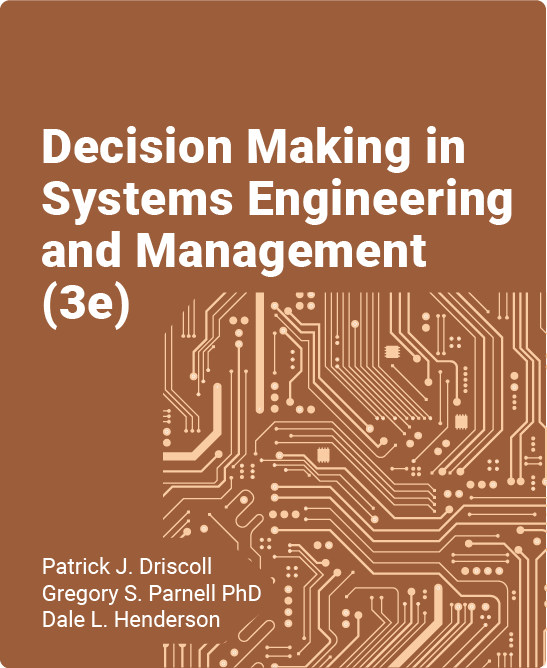Table of Contents
1 Working with Systems
1.1 Introduction
1.2 The Systems Engineering Perspective
1.2.1 Systems Trends That Challenge System Engineers
1.2.2 Fundamental Tasks of Systems Engineers
1.2.3 Relationship of Systems Engineers to Other Engineering Disciplines
1.2.4 Education, Training, and Knowledge of Systems Engineers
1.3 Systems thinking
1.4 System life cycles
1.4.1 System life cycle model
1.5 Other major system life cycle models
1.6 Systems Decision Process (SDP)
1.7 Stakeholders and Vested Interests
2 Applied Systems Thinking
2.1 Holism Framing Systems
2.1.1 Systems versus Analytic Thinking
2.1.2 Check on Learning
2.2 Element Dependencies
2.2.1 Check on Learning
2.3 Expansive and Contractive Thinking
2.3.1 Check on Learning
2.4 Structure
2.5 Classifying Systems
2.6 Boundaries
2.7 Visibility and Spatial Arrangement
2.7.1 Visibility
2.7.2 Spatial Arrangement
2.7.3 Check on Learning 76
2.8 Evolution and Dynamics
3 System Representations
3.1 Introduction
3.2 System Model Concepts
3.2.1 What Models Are
3.2.2 Role of Models in Solution Design
3.2.3 Qualities of useful models
3.2.4 Building System Models
3.2.5 Characteristics of models
3.2.6 Exercise the Model
3.2.7 Revise the model
3.3 Systemigrams
3.3.1 Systemigram Rules
3.4 Directional Dependency (D2) Diagrams
3.4.1 D2 diagrams into math representations
3.5 DSM and DMM Models
3.5.1 Dependency Structure Matrix (DSM)
3.5.2 System Adjacency Matrices
3.5.3 Check on Learning
3.5.4 Domain Mapping Matrix (DMM)
3.6 System Dynamics
3.7 IDEF0 Models
3.8 Simulation Modeling
3.8.1 Analytical Methods versus Simulation
3.8.2 Check on Learning
3.9 Determining Simulation Sample Size
4 The Systems Decision Process
4.1 Introduction
4.2 Value versus Alternative Focused Thinking
4.3 The SDP in Detail
4.3.1 The System Environment
4.3.2 When to Use the Systems Decision Process
4.3.3 Check on Learning
4.4 The Role of Stakeholders
5 Problem Definition
5.1 Purpose of the Problem Definition Phase
5.1.1 Comparison with Other Systems Engineering Processes
5.2 Research and “What is?”
5.2.1 Check on Learning
5.3 Stakeholder Analysis
5.3.1 Techniques for Stakeholder Analysis
5.3.2 At Completion FCR Matrix
5.4 Requirements Analysis
5.4.1 Margins
5.5 Functional Analysis
5.6 Assessing System Readiness
5.7 Initial Risk Assessment
5.7.1 Risk identification
5.7.2 Risk Mitigation
6 Value Modeling
6.1 Introduction
6.2 Qualitative Value Modeling
6.2.1 Measures
6.3 Quantitative Value Model
6.3.1 Value Functions
6.3.2 Value Increment Method
6.3.3 Weighting Options
7 Solution Design
7.1 Introduction
7.2 Ideation Techniques
7.2.1 Brainstorming
7.2.2 Brainwriting
7.2.3 Design Thinking
7.2.4 Affinity Diagramming
7.2.5 Delphi
7.2.6 Groupware
7.2.7 Lateral and Parallel Thinking and Six Thinking Hats
7.2.8 Morphology
7.2.9 EndsMeans Chains
7.2.10 Other Ideation Techniques
7.3 Screening and Feasibility
7.4 Improving Candidate Alternatives
7.4.1 Design of Experiments
7.4.2 Fractional factorial design
7.4.3 Pareto analysis
8 Costing Systems
8.1 Introduction
8.2 Types of Costs
8.3 Cost Estimating Techniques
8.3.1 Estimating by Analogy
8.3.2 Parametric Estimation Using Cost Estimating Relationships
8.3.3 Learning Curves
8.4 Time Effects on Cost
8.4.1 Time Value of Money
8.4.2 Inflation
8.4.3 Net Present Value
8.4.4 Breakeven Analysis and Replacement Analysis
9 Decision Making via Tradespace Analysis
9.1 Introduction
9.2 Tradespace Properties
9.3 Scoring Solution Alternatives
9.4 Scoring Options
9.4.1 Candidate Systems Scoring
9.4.2 Candidate Components Scoring
9.5 Tradespace Analysis on Scoring Results
9.5.1 Analyzing Sensitivity on Weights
9.5.2 Sensitivity Analysis on Weights Using Excel
9.6 Applying Valuefocused Thinking
9.6.1 Improving nonDominated Alternatives
9.6.2 Improving Dominated Alternatives
9.7 Supporting the Tradespace Decision
9.8 Use valuefocused thinking to improve solutions
9.8.1 Decision Analysis of Dependent Risks
9.9 Reporting and Decision Handoff
9.9.1 Developing the Report
9.9.2 Developing the Presentation
9.9.3 Presenting Analysis Results
9.9.4 Concluding the Presentation
9.9.5 Using a Storyline Approach
10 Stochastic Tradespace Analysis
10.1 Introduction
10.2 Uncertainty Concepts
10.3 Flaw of Averages Considerations
10.4 Uncertainty Distributions
10.5 Monte Carlo Uncertainty Simulation
10.6 Cost Uncertainty Modeling
10.7 Realization Analysis
10.7.1 Level 1 Analysis Choice
11 System Reliability
11.1 Modeling System Reliability
11.2 Math Models in Reliability
11.2.1 Common Continuous Reliability Distributions
11.2.2 Common Discrete Distributions
11.2.3 Check on Learning
11.3 Reliability Block Diagrams
11.3.1 Series System
11.3.2 Parallel System
11.3.3 Combined Series and Parallel RBD
11.3.4 Koutof N Systems
11.3.5 Complex Systems
11.4 Component Reliability Importance Measures
11.4.1 Importance Measure for Series System
11.4.2 Importance Measure for Parallel System
11.4.3 Check on Learning
11.5 Allocating and Improving Reliability
11.5.1 Check on Learning
11.6 Markov models of repairable systems
11.6.1 Kolmogorov Differential Equations
11.6.2 Transient Analysis
11.6.3 Steady State Analysis
11.6.4 CTMC Models of Repairable Systems
11.6.5 Modeling Multiple Machine Problems
12 Solution Implementation
12.1 Introduction
12.2 Solution Implementation Phase
12.3 The Initiating Process
12.4 Planning
12.5 Executing
12.6 Monitoring and Controlling
12.7 Closing
12.8 Implementation During Life Cycle Stages
12.8.1 Implementation in “Produce the System”
12.8.2 Implementation in “Deploy the System”
12.8.3 Implementation in “Operate the System”
12.8.4 Check on Learning
13 EpilogueProfessional Practice
13.1 Systems Engineering Activities
13.2 Working with the systems development team
13.3 Building an Interdisciplinary Team
13.4 Systems engineering responsibilities
13.5 Roles of the Systems Engineer
13.6 Characteristics of the Ideal Systems Engineer
13.7 Summary
zyText are leading print textbooks available in full on the zyBooks platform. Each zyText has been adapted to include learning questions and answer-specific feedback allowing for a quick and easy transition to an engaging digital experience for instructors and students.
What You’ll Find in this zyText
- Incorporates the complete text
- Over 150 learning questions with answer-specific feedback
- Customization tools letting you add, remove or reorder chapters and sections
- Options to align the book directly to your syllabus – including videos, images, text
- Analytics that help you measure student engagement
- Ability to hold students accountable for reading before class
- A competitive low price point
- Students can keep a PDF version of key chapters at no additional cost
A thorough introduction to working with systems, the systems engineering perspective, and systems thinking including:
- In-depth presentations of applied systems thinking, including holism, element dependencies, expansive and contractive thinking, and concepts of structure, classification, and boundaries
- Comprehensive explorations of system representations leading to analysis
- In-depth discussions of supporting system decisions, including the system decision process (SDP), tradespace methods, multi-criteria value modeling, working with stakeholders, and the system environment
Authors
Patrick J. Driscoll , Gregory S. Parnell , Dale L. Henderson

